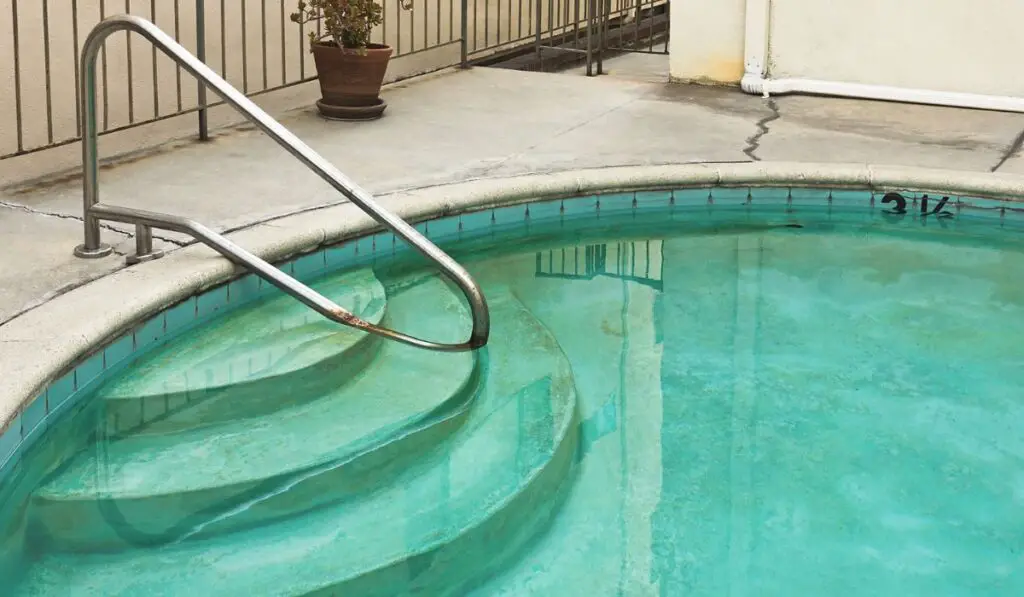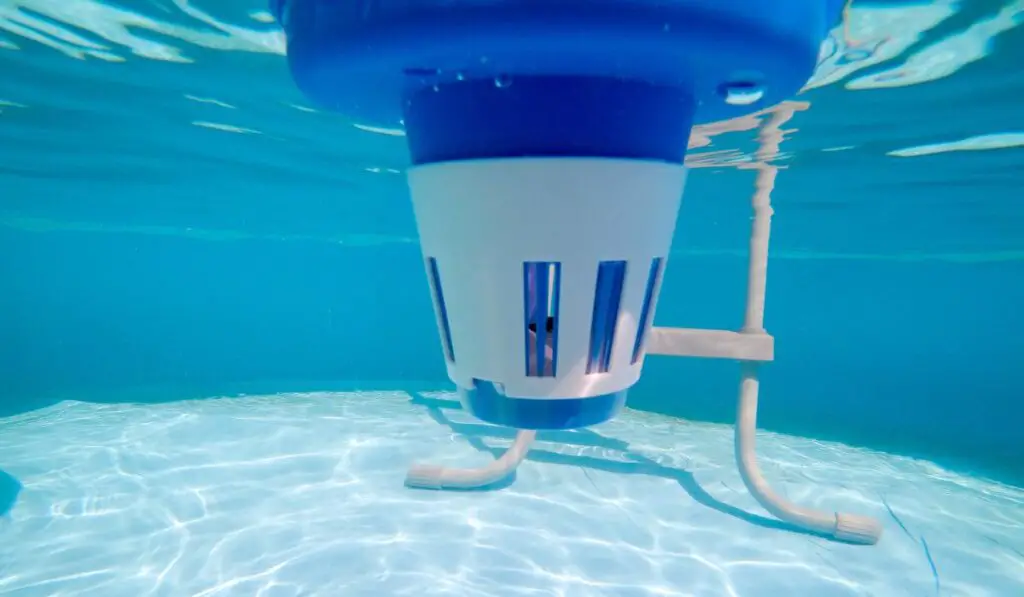Nobody wants algae to spoil their pool party experience, and the thought of a sickly green tint replacing the lovely shimmer of clear water is a big turnoff. But as disgusting as it is, algae can always grow in any pool and spread rapidly if left untreated. So how do you remove algae from your pool without a vacuum?
To remove pool algae without a vacuum, first balance the chemicals to stop new algae forming. Next, plan to run your pump constantly, 24hrs/day, while also brushing the floor and sides to store up algae that has settled regularly. This is labor intensive to pull off.
Let’s face it – removing algae is one of the most demanding pool maintenance tasks for which you’ll probably want to hire pool professionals. But it’s nothing compared to the trouble you’ll have to deal with if the yucky stuff is left to cloud the entire pool surface. Let’s dive into how you can get rid of it.
What Causes Algae To Grow?

Algae spores usually find their way into your pool through rainwater and wind. However, they can also get in through swimwear and pool equipment that’s not properly cleaned.
As a rule of thumb, assume the algae is always in your pool and will bloom upon the water meeting a specific set of favorable conditions.
Here’s why you’re seeing algae growth in your pool:
Poor Water Circulation
If your pool filter is clogged or the filter is too small to accommodate for your pool volume, the water will not circulate properly. What follows are dead spots in certain parts of the pool, and these are ideal areas for algae growth because pool chemicals don’t reach them.
Provided that the water circulates consistently in a small pool, you don’t have to worry about these low-flow areas. However, these can quickly become a problem if you own a large pool.
Experts recommend you carry out regular tests to determine if the water is flowing consistently in all areas of the pool or if there are spots where the flow is significantly reduced.
pH or Other Chemical Imbalance in the Water
The pH value of your pool should fall within the recommended range of 7.2 to 7.6. There are three things you need to check here as well — alkalinity, cyanuric, and calcium levels.
A high pH value indicates the pool is alkaline, and if there are low chlorine levels, this combo is terrible enough to encourage algae growth.
Minerals like calcium work actively to combat the overwhelming growth of algae in your pool. So, always ensure the pH level and mineral concentration are balanced.
Inefficient Water Filtration
Your pool’s water must pass through the filter regularly to maintain that appealing shimmer. But if your filter is clogged, small, or you run the pump for extremely short turnover periods, you’ll run into an algae problem.
You’ll know the filter isn’t working properly if your pool’s water is stubbornly murky, even if you stick to the recommended backwashing instructions. It’s important to replace the filter material after a few years.
Make sure you’ve connected the appropriate filter size for your pool, and run water through the filter for extended periods.
Poor Sanitation in the Pool
Low chlorine levels quickly translate to rapid algae growth in your pool. On a more scientific level, chlorine always blends with water to form a weak acid known as hypochlorous acid.
You can use various chlorine-based compounds for this process, including sodium hypochlorite and chlorinated isocyanurates.
An adequate amount of hypochlorous acid easily kills harmful bacteria and algae present in the water.
But with incredibly low or inconsistent chlorine levels, there won’t be enough acid to eliminate the harmful stuff and keep the water clean.
Is Swimming With Algae Dangerous?
Live algae aren’t directly harmful to anyone swimming in the pool, but they make the water appear cloudy and less appealing. If you swallow or inject the water and bacteria, then you open yourself up to various sicknesses – but just touching water with bacteria in it isn’t going to cause a problem for you automatically.
On top of that, the bacteria produces a foul smell, and you probably won’t want to put up with it.
Swimming in green slimy stuff isn’t the most refreshing experience, not to mention it makes it hard to maintain balance on the pool floor (because the algae makes everything slippery). It’s also a safety concern, because if a person or animal starts to struggle in the pool, it will be harder to see them through the murky waters.
So, while you may not get sick from swimming in dead algae water, it’s best to clear up the pool and make it more inviting and safer.
How Do You Remove Algae Without a Vacuum?
You’ll eventually need to quickly eliminate algae from your pool regardless of how they ended up there. Here’s how to remove them without a vacuum:
Clean the Pool Filter and Pump
Your pool filter clears most debris from your pool, including dead and loose algae. However, it can get clogged up over time, and you’ll need to backwash it thoroughly.
Just make sure you stick to the manufacturer’s recommendations to avoid damaging the filter unit.
Once you’ve cleaned your filter adequately, it will filter out any algae drawn into the filtration system through the pump.
Like your filter, check the pool pump to ensure it’s not clogged up by larger debris. Use a pool skimmer (on Amazon) or strainer to clean it up.
Thoroughly Brush Your Pool Floor and Walls
Most algae species produce a layer of slime to protect them from the pool cleaning products you use to get rid of them. You need to scrub off this slimy layer or else it will reduce the efficiency of your pool chemicals.
Use a hard brush (on Amazon) to scrub off the pool’s wall and floor surface, paying close attention to areas with plenty of algae and dirt. Loosen them so the pump will easily suck them.
Apply a Shock Treatment
Multi-purpose algaecide like calcium hypochlorite pool shock (on Amazon) comes in handy for removing even the toughest algae.
Make sure that you wear safety goggles and protective gloves when shocking your pool. Multipurpose algaecide products can burn your skin during handling.
Moreover, keep people from swimming in the pool a couple of days after you’ve shocked the water. Otherwise, anyone who swims shortly after the shock treatment will suffer skin rashes.
Use a pool clarifier (on Amazon) to clear the water if the pool looks green or murky following the process.
How To Clean Algae By Hand
Clearing algae from your pool by hand will take a lot of effort, time, and patience. Notably, it’s more common to find green, black, or yellow algae in your pool.
But whichever it is, you’ll first need to kill and loosen it, then gently sweep and pile it up so the pieces won’t scatter. Here’s how to remove the various types of algae from your pool by hand:
Black Algae
Black algae are quite tough, and you first need to kill them by pouring baking soda over the pool walls. Next, scrub the dark spots with a stiff brush to dislodge the algae and collect it with a net.
You can also take it out with a dustpan once it’s settled at the bottom of the pool.
Green Algae
Apply household borax (on Amazon) to the algae-infested spots to kill them and prevent them from multiplying. Next, loosen them with a hard brush and wait for the water to settle. Carefully collect the dead algae with a net or scoop it out with a dustpan.
Yellow Algae
While yellow algae can grow deep, it’s the least stubborn. Sprinkle baking soda over the algae and use a stiff brush to scrape it off
Let the pool water settle, then carefully scoop out the algae with a dustpan. Don’t drain out the pool at this time, or the algae will clog the filtration system.
Testing Your Water Levels
Once you shock your pool, the pH level should rest between 7 and 7.6, and the alkalinity level should range between 80 – 120 ppm.
Grab a pool testing kit (on Amazon) and test these levels to ensure everything is perfectly balanced, and the algae will slowly start to die. Your chlorine level should be over 3 ppm, and you can always add chlorine tablets to beef it up.
If you’ve tested the alkalinity level and determined it’s below the standard, add alkaline granules (also on Amazon) to restore the level to normal.
You’ll know the algae is slowly dying once it turns brown, and it will sink to the bottom of the pool.
How To Shock Your Pool
Most pool owners prefer shock cleaning to vacuums and algaecides because it’s cheaper. It’s also a simple process that requires basic tools you could buy or probably have at home already. Here’s a quick highlight of some of the things you’ll need:
- Calcium hypochlorite solution
- Eyewear
- Hand gloves
- A bucket
It would be best to get 1 to 4 gallons of the hypochlorite compound, depending on the size of your pool. Once you’re set with the requirements, follow these steps:
- Put on your safety glasses and hand gloves.
- Fill a 5-gallon bucket with water to the brim.
- Carefully introduce a pound of shock to the water and stir gently until it’s fully dissolved.
- Next, scan your pool to identify the spots most infested with algae. If the algae have covered a massive portion of your pool, double the hypochlorite quantity.
- For best results, add the shock solution at night and let the pump and filter run overnight. The water will circulate evenly, and the shock will kill the algae more effectively, leaving your pool clean.
How To Prevent Algae From Growing in Your Pool

Dealing with algae is annoying and time-consuming, but unfortunately, it’s nearly impossible to eradicate them. Keep in mind that algae tend to thrive when the sunlight is sufficient and the weather is warm.
Here’s some tips for preventing algae from growing in your pool:
- Ensure proper circulation in your pool by doing routine clean-ups of your pump and skimmer. Algae spores usually collect underneath the skimmer and spread rapidly if you don’t clean it thoroughly.
- Shock the pool regularly to kill the present algae and reduce the amount of growth in the future.
- Brush your pool properly, working thoroughly with a nylon or wire brush on the common algae spots.
